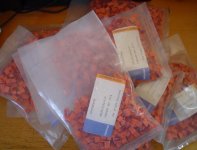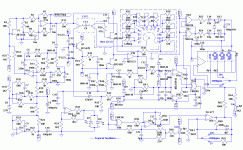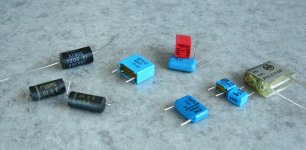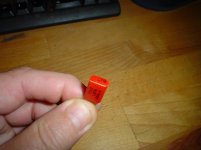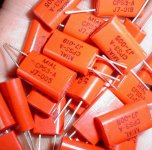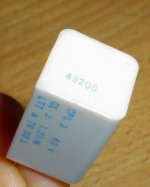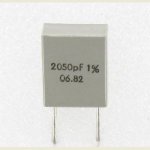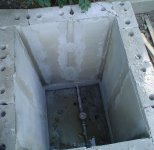I'm putting together some upgraded version of some RIAA amps and active crossover circuits. I have the choice of several caps for filter duty, including the green Russian polystyrene caps available on Ebay, some Rifa PFE225 radial polystyrenes, some Mallory radial polystyrenes that are a Rifa PFE225 look-alike (same style case, red instead of white), and as an alternative, Roederstein MKP1830 and 1840 series polypropylene caps. These would be used in RIAA passive and jfet follower-based Sallen-Key active filters.
Does anyone have any useful experience with these caps? I suspect they're all pretty decent, but are some more decent than others?
Does anyone have any useful experience with these caps? I suspect they're all pretty decent, but are some more decent than others?
Obviously, the Roederstein MKP1840 is the only of the lot for higher uF values, but Metallised foil.
The Metal Foil KP1830 (1837) is the choice for lower values, if a high voltage rating is required.
For RIAA and X-over, my preference goes to Polystyrene caps, provided they're the extended foil kind.
The box-type Polystyrene cap in general is the variety with interleaved foils, the RiFa PFE225 has the disadvantage of fairly large size and 2% accuracy.
Others came in 1% grade, such as the filthy expensive Siemens KS, all just as easy to solder as a KP1830, due to the thick leads and large epoxy resin mass.
Example of ITT KS (= Kunststoff Styroflex) caps :
Wieder mal 'ne Kondensatorfrage - Phono - Restauration und Selbstbau - Analog-Forum
Others : http://www.analog-forum.de/wbboard/index.php?page=RGalleryImageWrapper&itemID=4786&type=image
Never seen/heard of radial Mallory polystyrenes, a picture would be grand.
The Metal Foil KP1830 (1837) is the choice for lower values, if a high voltage rating is required.
For RIAA and X-over, my preference goes to Polystyrene caps, provided they're the extended foil kind.
The box-type Polystyrene cap in general is the variety with interleaved foils, the RiFa PFE225 has the disadvantage of fairly large size and 2% accuracy.
Others came in 1% grade, such as the filthy expensive Siemens KS, all just as easy to solder as a KP1830, due to the thick leads and large epoxy resin mass.
Example of ITT KS (= Kunststoff Styroflex) caps :
Wieder mal 'ne Kondensatorfrage - Phono - Restauration und Selbstbau - Analog-Forum
Others : http://www.analog-forum.de/wbboard/index.php?page=RGalleryImageWrapper&itemID=4786&type=image
Never seen/heard of radial Mallory polystyrenes, a picture would be grand.
Attachments
Last edited:
Rifa pfe225
I would suggest you avoid the Rifa pfe225 extended foil caps - unfortunately, they're not particularly good - originally intended for the vocal range in phone systems.
Now the Rifa pfe216 styrenes, they are very good, but also physically large, and there is a limited range of these NOS caps at "Rockby Electronics" in Oz.
I would suggest you avoid the Rifa pfe225 extended foil caps - unfortunately, they're not particularly good - originally intended for the vocal range in phone systems.
Now the Rifa pfe216 styrenes, they are very good, but also physically large, and there is a limited range of these NOS caps at "Rockby Electronics" in Oz.
In the active crossover I'm currently building, I went with Roederstein KP1830 caps (1n5, 100V). They're very compact, and the value is pretty much perfect for a crossover fequency range of 5-6 kHz. I used the Russian K71-7 series polystyrenes (100nF, 250V) for input coupling and high-pass output coupling, and some Aerovox AFPS series polypropylenes (3uF, 450V) for loww-pass output coupling. The Aerovox caps reportedly sound pretty good, in spite of their humble origins.
Aerovox AFPS
Why humble, there's nothing wrong with the Mexi-Cans.
http://www.youtube.com/watch?v=gQU02n358VY
Last edited:
I have a whole mess of odd polystyrene and polypropylene caps acquired over the years. Sadly, the only Siemens caps I've seen are the usual metalized polyesters (and a stacked foil or two). I've been collecting a fair number of Arcotronics, Rifa, and GE HV, high current metallized polypropylenes for coupling duty in tube amps. I have a sprinking of old-style Rifa polystyrene caps, including some PFE210 caps that are very obviously extended foil units, as they are encapsulated in clear resin so you can see exactly what's going on at the end terminations.
Hi,
what is an extended foil polystyrene?
How do you recognise it?
How bad is a polystyrene that is not extended foil?
I thought aluminium foil and polystyrene insulator were all that was needed for a good audio cap.
Do they make stacked film polystyrene?
All mine are clearly a long continuous coil.
what is an extended foil polystyrene?
How do you recognise it?
How bad is a polystyrene that is not extended foil?
I thought aluminium foil and polystyrene insulator were all that was needed for a good audio cap.
Do they make stacked film polystyrene?
All mine are clearly a long continuous coil.
PFE210 caps have both excellent accuracy and near record tan-δ (62ppm for a 100nF), but so very long out of production that only the lucky few have practicable values left.
Downside (to me) is the large size again, as the PFE216.
For large values, my preference goes to box types as the PFE225 for phono and active x-over.
Not all axial polystyrene caps (transparents) are crummy btw, some 63Vdc Siemens and Philips types were fine sounding extended foils, measure swell to.
That the turntable and phono stage business has become a niche market is a rotten shame, for phono nutters such as myself it has the pleasant upside that high accuracy polystyrene caps are up for grabs.
41Hz Audio:Cap 63V Film 215pF Polystyene
Downside (to me) is the large size again, as the PFE216.
For large values, my preference goes to box types as the PFE225 for phono and active x-over.
Not all axial polystyrene caps (transparents) are crummy btw, some 63Vdc Siemens and Philips types were fine sounding extended foils, measure swell to.
That the turntable and phono stage business has become a niche market is a rotten shame, for phono nutters such as myself it has the pleasant upside that high accuracy polystyrene caps are up for grabs.
41Hz Audio:Cap 63V Film 215pF Polystyene
Attachments
Here are some of the caps I've picked up via Ebay/local surplus. The two black caps in the lower left hand corner are PSBPC caps froom American Radionics. I suspect they are polystyrene, but I'll have to crack one open to make sure. The black, long leaded cap above them is a STK KP80S polypropylene film/foil. The largish blue cap in the middle is a Roederstein MKP1840 metallized polypropylene. The red cap propped up on the blue one is the Mallory polystyrene box cap I mentioned. The blue cap in the foreground below it is an old Wima FKS series film/foil. I just looked it up, and its polyester film/foil - too bad. The two tiny caps to the right of it are Roederstein KP1830 polypropylene film foil - these are what I'm using in my jfet active crossover.. The cap to the far right is a Rifa PFE210. It's one I'm considering for a tube-based RIAA amp. It's 7.41 nF, which is right near the value I need for the upper break point. I'm thinking of using an STK KP80S 22nF cap for the lower break point.
Attachments
MIAL was Mallory owned ? Didn't know that.
I've got a whole bunch of MIAL CPS3 caps, CPS is the French abbreviation for Condensateur Poly-Styrene.(or Plastique Styrene)
(i'll post a picture of a Precis CPS3 cap tomorrow, a Frenchie too)
I've got a whole bunch of MIAL CPS3 caps, CPS is the French abbreviation for Condensateur Poly-Styrene.(or Plastique Styrene)
(i'll post a picture of a Precis CPS3 cap tomorrow, a Frenchie too)
Attachments
Last edited:
Got the straight scoop after some searching - Mial was a German capacitor company that was acquired by TRW. TRW capacitors were acquired by Shizuki, and are now American Shizuki/ASC. I should drag out some of the various polystyre caps I have and sort out who made what. If you have Mial capacitors, they are pretty old, as apparently the company was acquired by TRW in 1978.
The maisonette caps likely fit inbetween stacked MKP's, say a B32620, and metal foil ones, i'm only familiar with the lower rated foil-only 73 Italians.
Taste is in the trying.
Back in the old DIY days, without access to multi-k drool tools, a basic taste test was eased up by comparing parts which were furthest apart in construction.
Example is a direct comparison between a Roederstein KP1830 and a double-sided metalised MKP1836 of the same manufacturer.
Question is why bother ?
The fun part of being an old and less hairy fckr nowadays is that most know JS about old production parts, not even traders, example is a Philips (label) KS443 box type cap.
Those are excellent polystyrenes (quite popular in DIY Japan btw), but funny enough harder to obtain here in the g.o.d than the ones described earlier.
TEDSS in South Carolina offers a couple of KS443 values for $0.05 each, for 500 minimum. (hasn't been interesting for me due to the high foreign mail/handling cost)
And there are boutique parts from the telecom industry, the grey one is a cap manufactured by Alcatel.
Let's get totally Naked for an example of a "high end" axial polystyrene :
http://www.komponenten.es.aau.dk/fileadmin/komponenten/Data_Sheet/Generelle/KS429.pdf
(i turn jello when i talk epoxy resin, made all kinds of composite stuff with it, from home construction to a 40ft sail yacht.
My hands-on experience with it ranges from navy vessel sonar domes to commercial airplane parts, from automobile body filler to garage floor epoxy coating. I'm currently working on an all-new pit for the water meter, 5ft deep, will also receive an all-side epoxy coating.
Manufacture date of resin sealed/filled foil caps doesn't bother me. )
Taste is in the trying.
Back in the old DIY days, without access to multi-k drool tools, a basic taste test was eased up by comparing parts which were furthest apart in construction.
Example is a direct comparison between a Roederstein KP1830 and a double-sided metalised MKP1836 of the same manufacturer.
Question is why bother ?
The fun part of being an old and less hairy fckr nowadays is that most know JS about old production parts, not even traders, example is a Philips (label) KS443 box type cap.
Those are excellent polystyrenes (quite popular in DIY Japan btw), but funny enough harder to obtain here in the g.o.d than the ones described earlier.
TEDSS in South Carolina offers a couple of KS443 values for $0.05 each, for 500 minimum. (hasn't been interesting for me due to the high foreign mail/handling cost)
And there are boutique parts from the telecom industry, the grey one is a cap manufactured by Alcatel.
Let's get totally Naked for an example of a "high end" axial polystyrene :
http://www.komponenten.es.aau.dk/fileadmin/komponenten/Data_Sheet/Generelle/KS429.pdf

(i turn jello when i talk epoxy resin, made all kinds of composite stuff with it, from home construction to a 40ft sail yacht.
My hands-on experience with it ranges from navy vessel sonar domes to commercial airplane parts, from automobile body filler to garage floor epoxy coating. I'm currently working on an all-new pit for the water meter, 5ft deep, will also receive an all-side epoxy coating.
Manufacture date of resin sealed/filled foil caps doesn't bother me. )
Attachments
Last edited:
- Status
- This old topic is closed. If you want to reopen this topic, contact a moderator using the "Report Post" button.
- Home
- Source & Line
- Analog Line Level
- Polystyrene Caps For Filters
